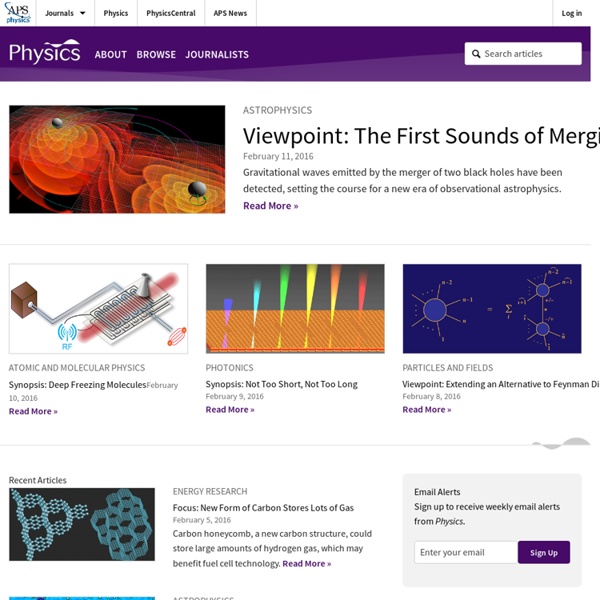



Physics Various examples of physical phenomena Physics is one of the oldest academic disciplines, perhaps the oldest through its inclusion of astronomy.[8] Over the last two millennia, physics was a part of natural philosophy along with chemistry, certain branches of mathematics, and biology, but during the Scientific Revolution in the 17th century, the natural sciences emerged as unique research programs in their own right.[b] Physics intersects with many interdisciplinary areas of research, such as biophysics and quantum chemistry, and the boundaries of physics are not rigidly defined. New ideas in physics often explain the fundamental mechanisms of other sciences[6] while opening new avenues of research in areas such as mathematics and philosophy. Physics also makes significant contributions through advances in new technologies that arise from theoretical breakthroughs. History
Physics News - Physics News, Material Sciences, Science News, Physics Study reveals traits and evolutionary history of carnivorous bats (Phys.org)—A pair of researchers with the University of Washington has found similarities between different types of carnivorous bats compared to those that are insectivores or those that eat fruit, nectar or of course ... Monkeys and humans share staring behavior Following another's gaze is a hallmark of human learning and socialization from infancy to old age. Humans change how they follow gazes throughout life, and disruptions in the ability to follow someone's gaze are warning ... Teachers' Tech Tools for Physics Let's face it. Teaching physics is not a walk in the park. With all the overwhelming formulas, strange symbols and abstract concepts, it takes a lot of effort for teachers to impart knowledge to their students -- especially if the students are kids.
physicscentral Matrix67: The Aha Moments 随着常数 m 和 n 的变化,参数方程 x = sin(m · t), y = sin(n · t) 将会画出一系列漂亮的曲线。法国物理学家 Jules Antoine Lissajous 曾在 1857 年研究过这类曲线,因此人们把它叫做 Lissajous 曲线。我在 reddit 上看到了一个 Lissajous 曲线的动画演示,觉得看起来确实非常爽;但那个动画里没有解释曲线的生成方法,很多细节也有让人不太满意的地方,于是决定自己制作一个。这个动画展示的是 m = 13, n = 18 时的 Lissajous 曲线。 Physics & Physical Science Demos, Labs, & Projects for High School Teachers Normal Distribution Calculator The Normal Distribution Calculator makes it easy to compute cumulative probability, given a normal random variable; and vice versa. For help in using the calculator, read the Frequently-Asked Questions or review the Sample Problems. To learn more about the normal distribution, go to Stat Trek's tutorial on the normal distribution. Note: The normal distribution table, found in the appendix of most statistics texts, is based on the standard normal distribution, which has a mean of 0 and a standard deviation of 1. To produce outputs from a standard normal distribution with this calculator, set the mean equal to 0 and the standard deviation equal to 1. Instructions: To find the answer to a frequently-asked question, simply click on the question.
The Physics Classroom Transcript of the Constitution of the United States - Official Text The Constitution of the United States: A Transcription Note: The following text is a transcription of the Constitution as it was inscribed by Jacob Shallus on parchment (the document on display in the Rotunda at the National Archives Museum.) Items that are hyperlinked have since been amended or superseded. The authenticated text of the Constitution can be found on the website of the Government Printing Office.
Iraqi Civil Society Solidarity Initiative (ICSSI) Policy Paper Presented to the Iraqi Government on the legal possibilities available to Iraq to respond to the threat posed by the Ilisu Dam. Author: Save the Tigris and Iraqi Marshes Campaign Baghdad, 22-03-2014 Download the full paper here (PDF file) or read the full content below. Contents: The Psychology Career and Education Center